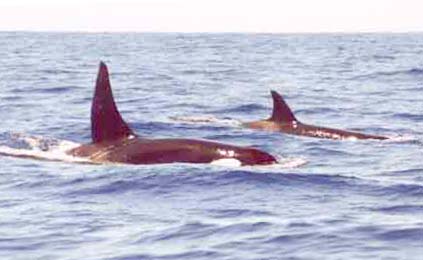


Whale foundation Research volunteer Bridgid Thomas was briefed on the different animals she might encounter while surveying for marine mammals near Maui.
group spots orcas
off Lanai
The rare encounter with a pod
of 6 orcas lasted about 2 hoursBy Kelliann Shimote
kshimote@starbulletin.comThe list included pilot whales, spinner dolphins, rough-tooth dolphins, spotted dolphins and bottlenose dolphins. It said nothing about killer whales
But on Saturday the nine-member crew of the Pacific Whale Foundation boat Ocean Explorer encountered a pod of six killer whales, or orcas.
The encounter, about 14 miles off Lanai and lasting about two hours, is extremely rare for Hawaiian waters, said foundation research associate Mandy Migura. The last recorded orca sighting in the area was in March 1997 by a fisherman six miles off Kaneohe Bay.
"We were all pretty excited," Thomas, 21, said yesterday. "We weren't scared, just totally amazed."
The Pacific Whale Foundation group said they first spotted a 6-foot dorsal fin of a male orca approaching the boat along with two females, two juveniles and one calf.
"Once we saw the animal's dorsal fin, we slowed down until we came to a stop, and then at that point we just watched and observed their behavior," Migura said.
During that time, she said, they noticed the pod doing 10- to 12-minute-long deep dives. They concluded the pod was feeding because they observed remnants of octopus.
Migura said that at one point some orcas swam under the boat and turned on their sides. "It did appear they were investigating or observing us," she said.
The crew returned to Lahaina while the pod kept feeding.
Migura said killer whales belong to two types of pods: resident pods and rogue pods. She believes this group is a rogue, or transient, pod because they were found far from their cold-water home ranges.
Foundation President Greg Kaufman said orcas are often found along areas off the Western United States, Australia and Latin America.
He said the mammals are misnamed and are actually dolphins. Rogue pods run in smaller groups of 10 or less and typically feed on other animals besides herring, which resident orcas feed on.
Kaufman said rogue pods tend to be more aggressive, while resident pods feed and live in their own defined areas.
"Hawaii is the most isolated island chain in the world, and so it's unusual to see orcas leave the mainland ... and out towards Hawaii," he said.
Kaufman said the scientific community uses the terms rare, uncommon, seldom-seen and common to describe how often animals are seen in a certain area. He said the killer whale would rank rare or uncommon in Hawaiian waters.
"I would say the likelihood is that ... they are moving through and that they're opportunistic feeders," he said.
He said the marine mammals are not a threat to humans. But Kaufman urged those who see the dolphins not to enter the water because sharks often follow them to pick up scraps.
"They are fairly sloppy eaters," said Kaufman. "One could be surprised if they go in the water and found there are a fair number of oceanic or pelagic sharks around them when they're feeding."
This rare encounter has left the staff feeling quite lucky.
"It was pretty amazing," Thomas said. "They're just known to be in captivity so much that was just good to see them swimming in the wild and free."